Psion Series 3
 | |
| Manufacturer | Psion PLC |
|---|---|
| Type | PDA |
| Retail availability | 1993 |
| Media | Psion Solid State Disks |
| Operating system | SIBO (EPOC16) |
| CPU | NEC V30H @ 7.68 MHz |
| Display | 480 × 160 monochrome LCD, 13.1 cm (5.16 in) |
| Input |
QWERTY keyboard microphone stylus |
| Camera | N/A |
| Touchpad | N/A |
| Connectivity | Serial, 19200 bit/s RS-232C |
| Power | 2 × AA battery |
The Psion Series 3 range of personal digital assistants were made by Psion PLC. The four main variants are the Psion Series 3 (1991), the Psion Series 3a (1993), the Psion Series 3c (1996), and the Psion Series 3mx (1998), all sized 165 × 85 × 22 mm. In addition, a Psion Series 3a variant with factory installed software for the Russian language was called a Psion Series 3aR, and Acorn Computers sold a rebadged version of the Psion Series 3 and 3a marketed as the Acorn Pocket Book and Acorn Pocket Book
The Psion Series 3 range is regarded by writer Charles Stross as an unsurpassed PDA[1] because of its long battery life (20 to 35 hours), its stable and versatile software, and its durable hardware.[2] About 1.5 million Psion 3s were made.
The Psion Series 3 models were a major advance on the Psion Organiser. They had an original way of managing files: the available program icons are shown in a horizontal line and the associated files drop down beneath them. Manufacture of Psion 3s was discontinued in 1998 shortly after the launch of the Psion Series 5 (a Psion Series 4 does not exist, due to Psion's concern of tetraphobia in their Asian markets) and the Psion Siena. Psion's industrial hardware division continue to produce handhelds running the same 16-bit operating system, some 17 years after its introduction on the Psion MC range of laptops and 5 years after Psion Computer's final 32-bit EPOC PDA was released.
All the Series 3 variants were powered by two AA battery cells which are easily obtainable, rather than having a specially shaped proprietary battery which might be difficult to replace. They all have an internal backup battery in the form of an easily changed small button cell, which enables the main AA batteries to be changed without losing any of the data files. In addition they all have a DC input socket for optional external power-supply via a mains transformer.
The Series 3's innovative clamshell design did have some problems: breakages of any of the four hinges; loss of function in the button bar between the two halves of the clam; and deterioration of the cable linking the keyboard half to the screen, leading to a serious display problem with the appearance of vertical lines.
Psion Series 3s have room for two flash-memory cards, which enabled backup of data. Psion, Acorn and third party software was available loaded onto such memory cards which were available as separate packs.
The Series 3 featured a tone dialing feature using a combination of its built-in loudspeaker and dedicated software for generating tones suitable for telephone systems. It could be used to dial a telephone number by holding the device to the mouthpiece of a tone dialing telephone. The tone dialing feature was integrated into the Psion's Agenda, Contacts and Data applications.[3]
One unique feature of the Psion Series 3 software package was a built-in programming language, OPL (Organiser/Open Programming Language), which enabled users to create their own applications that ran and looked just as system programs. This, along with the rise in popularity of forums such as Compuserve and CIX, led to a significant shareware scene, (still) archived by Steve Litchfield and the 3-Lib shareware library, started in 1994. This Psion shareware scene was mirrored a few years later by the PalmPilot shareware scene and both were forerunners of the 'app'-centric mobile world that we have today.
The Embeddable Linux Kernel Subset project has produced a small subset of Linux that runs on the Series 3a.[4]
Psion Series 3
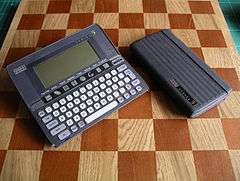
The Psion Series 3 was the first truly useful Personal Digital Assistant or PDA. Its purpose was to replace the old-fashioned paper agenda and Rolodex, but it could do much more. Besides the agenda with multiple views, it featured a database, a word processor, a spreadsheet with charts, world times and more. With an optional modem, it could connect to the Internet. It could be programmed in OPL (Organiser Programming Language), with easy access to menu and graphical functions. The Series 3 had a 240×80 pixel screen of 97×39 mm.[5]
Acorn Pocket Book

Essentially a rebadged OEM version of the Series 3 with slightly different on-board software, the Acorn Pocket Book was marketed by Acorn Computers as an inexpensive computer for schoolchildren, rather than as an executive tool.[6] The hardware was the same as the Series 3, but the integrated applications were different; for instance, the Pocket Book omitted the Agenda diary application, which became an optional install from floppy diskette. Other programs were renamed: 'System' became 'Desktop', 'Word' became 'Write', 'Sheet' became 'Abacus' and 'Data' became 'Cards'.[7]
Psion Series 3a
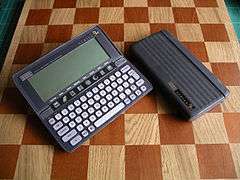
The most obvious upgrade to the Psion 3a is a larger screen, now 480 x 160. The Series 3a has a NEC V30H CPU (running at 7.68 MHz), a microphone for voice recording, an I/O port (for modem, printing and PC synchronization), and 256 kB, 512 kB, 1 MB or 2 MB of RAM. The backup battery for the Series 3a is a CR1620. The Psion Series 3a range was revised in 1995 to include models with 1 MB or 2 MB of RAM and additional software was factory preloaded into the ROM. This included a spell checker and thesaurus, Comms software, games and more, though all of these had been available previously as optional extras (or in the case of the Comms software, as a program loaded from the ROM of the 3Link serial connector) for earlier models.
Acorn Pocket Book II
As a successor to its slightly-modified Pocket Book, Acorn also produced a rebadged 3a named the Pocket Book II. This added back some of the applications omitted from the original Pocket Book, so was closer in specification to the standard Psion model. For instance, Psion's 'Agenda' application was replaced, although renamed 'Schedule', and a new Plotter application (graph-plotting software) was added.[8] The Pocket Book II came in either 256 KB, 512 KB or 1 MB variants.[6]
Psion Series 3aR
There was also a modification of the Series 3a for Russian market named Psion Series 3aR, which had software factory installed directly in the ROM for the Russian language. All the other Series 3 models had software for the English language factory installed and localization required installation of localization software, which was bundled in the box with the Psion palmtop.
Psion Series 3c
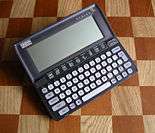
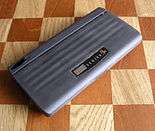
The Psion Series 3c was the next variant after the Psion Series 3a. (A Psion Series 3b does not exist). It has a slightly different external appearance to the earlier variants because a redesigned badge is placed centrally on the lid, the lid has fewer undulations, and a port for an infrared connection is visible. The plastic case is painted matte dark grey. The backup battery for the Series 3c is a CR1620.
The Series 3c, and the later 3mx, have an Easter Egg. In the System Screen, if you display the "About" screen, then type:
!Mrs T Bogan!
the English anthem "Jerusalem" is played, followed by a list of credits. (It is a one-shot affair; if you mis-type, you need to kill/restart the System Screen with Ctrl+Psion+Shift+K before you can retry.)
Psion Series 3mx
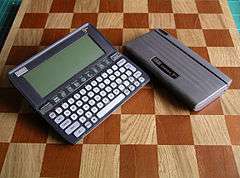
The Psion Series 3mx was the last upgrade in the popular 16-bit (SIBO) Series 3 line. Announced in July 1998, after the release of the 32-bit (EPOC) Psion 5, the 3mx is essentially an upgraded Series 3c. The 3mx comes in two models: 1 MB and 2 MB.
The Psion Series 3mx and Series 3c have a similar overall external appearance, except the 3mx sports a matte silver metallic paint covering, rather than the dark grey finish of the 3c.
The Series 3mx has a faster processor: a 16 bit NEC V30MX (80C86 compatible) running at 27.684 MHz, and a faster RS232c connection, which was boosted to 115 kbit/s. For compatibility with legacy software the processor speed can be reduced by pressing Ctrl + CapsLock.
All models of the Series 3mx came with a backlit screen, also some 3cs (mainly for the USA market) had backlit screens. The screen backlight can be switched on and off by pressing the space bar whilst the special function key is pressed.
The Series 3mx takes a CR2025 backup battery which is larger than the CR1620 that is used for the previous series 3 Psion models.
Like many other Series 3 models, the 3mx uses an infrared port which can be used to transfer data between two devices.
The capability to browse the World Wide Web on the device was also available through STNC HitchHiker,[9] although it was only available for use with an external modem. Due to the black and white screen, this was often not the most practical way of browsing the web.
Accessories
Software packs
Software packs were optional extras. Software was available from Psion PLC or from third parties, such as Purple Software, PsionPages or Widget UK. In later years software became available via download.[10] The software memory unit slots into either of two bays - there is one bay hidden by a swivel locking door at each end of the Psion Series 3 models.
The spell software pack is for the early models that did not have a spell checking facility pre-loaded.
Memory modules

The older RAM needed a button cell to keep the data stable in the memory. One button cell fitted into each module.
The later memory modules, flash I and flash II, did not need a battery and were cheaper for each capacity (both versions continued being manufactured).
The flash modules did have the limitation of needing to be re-formatted entirely to reclaim space from deleted or modified files; old versions of files which were deleted or modified continued to take up space until the module was formatted. This made the RAM modules more desirable for use where the data stored was likely to be changed frequently, as every change with a flash module meant writing a new version of the file into the remaining space.
Psion Travel Modem
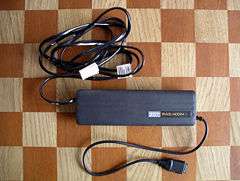
The Psion Travel Modem is an optional extra. They were made at the Psion Dacom plc factory in Milton Keynes, England. The connections to the Psion Series 3 and 3a are different from those for the Series 3c and 3mx.
See also
References
- ↑ News from the IT travel department (Charles Stross, 15 September 2009)
- ↑ I can personally verify this durability. I'm still using the same Psion 3mx I bought in 1998, and have used almost daily since. (Roy K Gillard ) Added August 2015
- ↑ "Psion Epoc Phone Dialer". ericlindsay.com. 2007. Retrieved 2007-08-08.
- ↑ Introduction to ELKS
- ↑ patricklog.com. patricklog.com. Retrieved on 2013-12-08.
- 1 2 Chris's Acorns: Acorn Pocket Book. Acorn.chriswhy.co.uk (2008-01-16). Retrieved on 2013-12-08.
- ↑ http://acorn.chriswhy.co.uk/docs/Acorn/PR/Pocket_Book_launch.txt
- ↑ http://acorn.chriswhy.co.uk/docs/Acorn/PR/Pocketbook_II_Launch.txt
- ↑ "STNC's HitchHikerTM smartphone solution granted Millennium Product status" (Press release). STNC. 2 November 1998. Archived from the original on 20 February 1999. Retrieved 16 April 2011.
- ↑ Widget Looks to Web for Efficient Software Sales, Computagram
External links
- Unofficial history of Psion
- Official Psion PDA Support Site
- Clive Feather's Psion 3 stuff
- David MacKay's repair tips
| Wikimedia Commons has media related to Psion Series 3. |